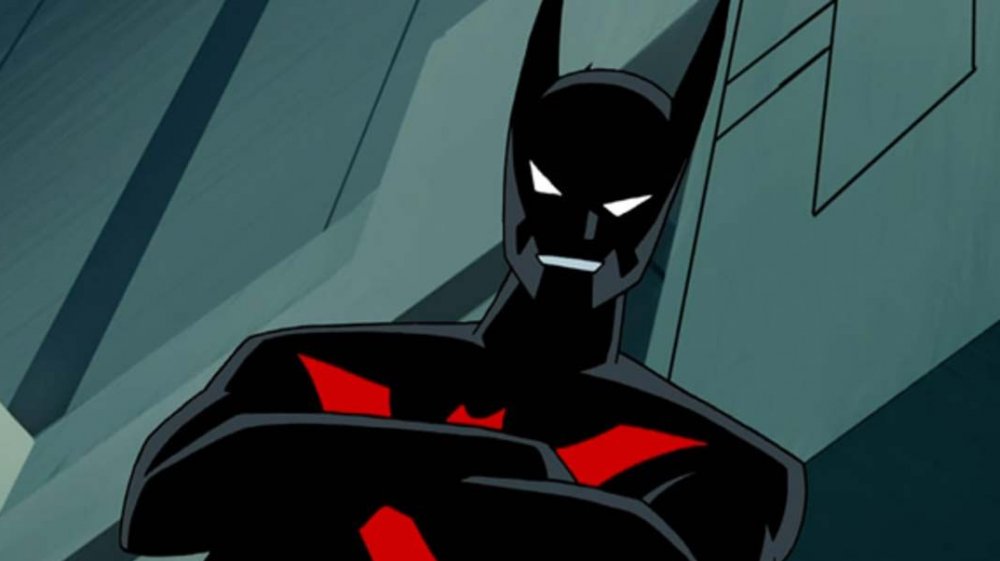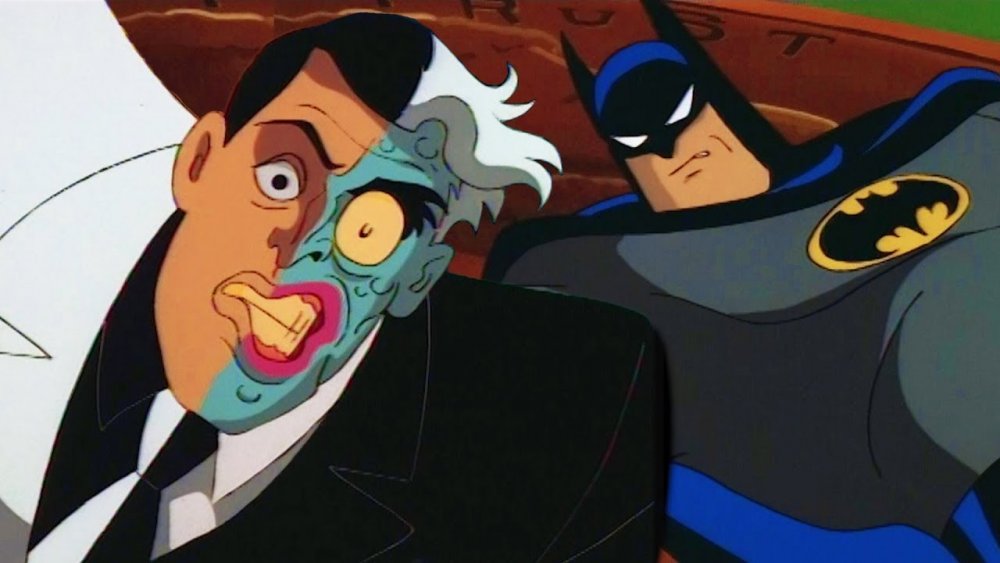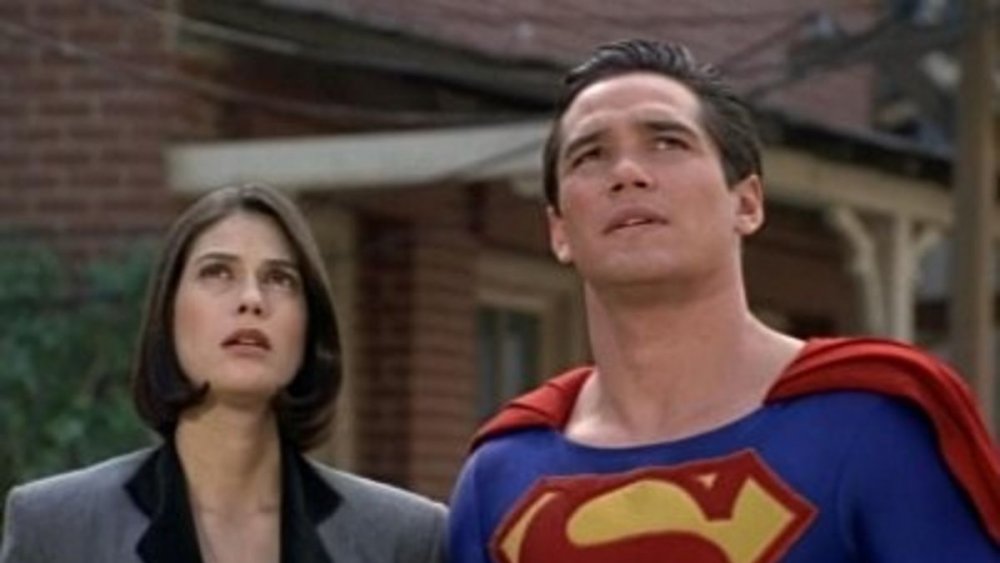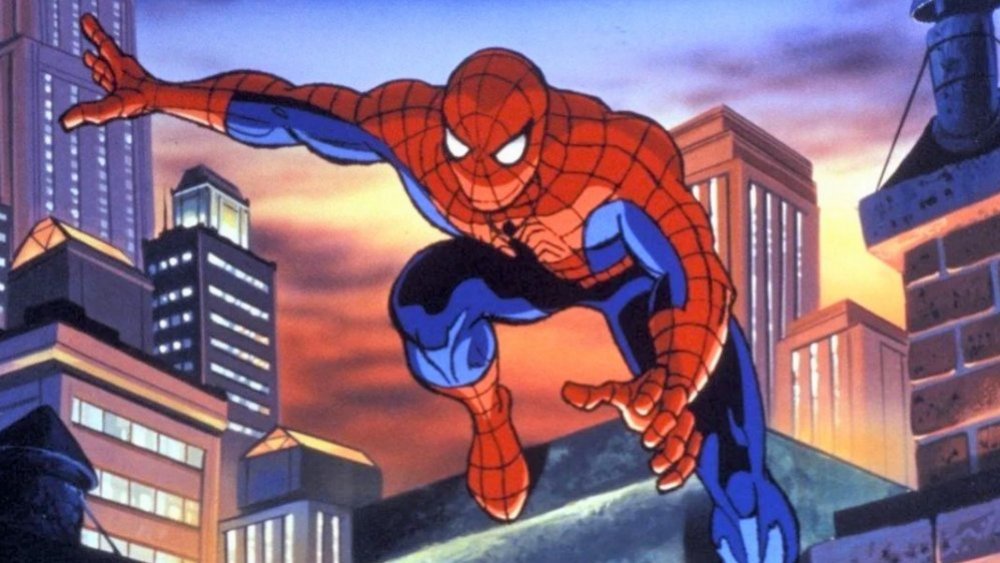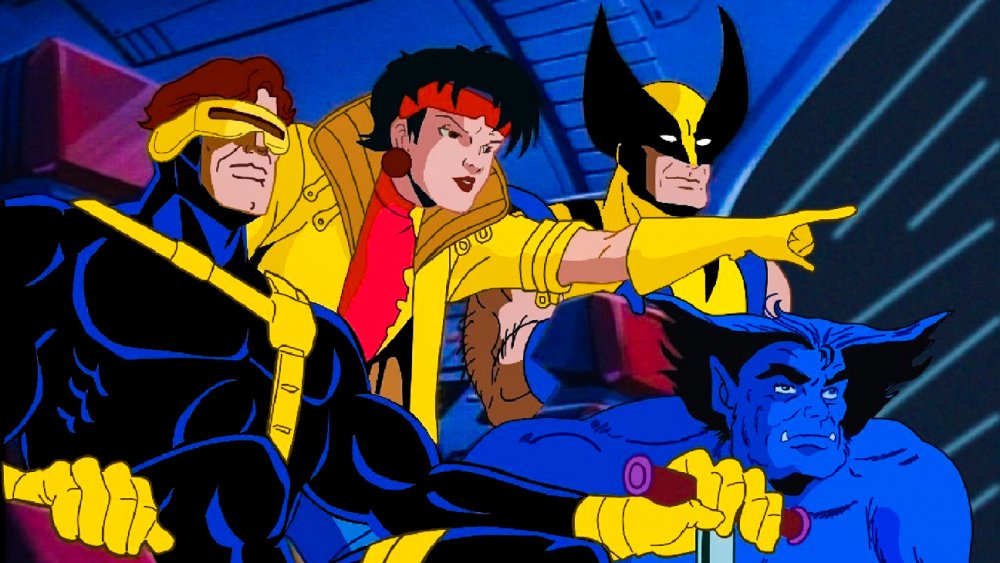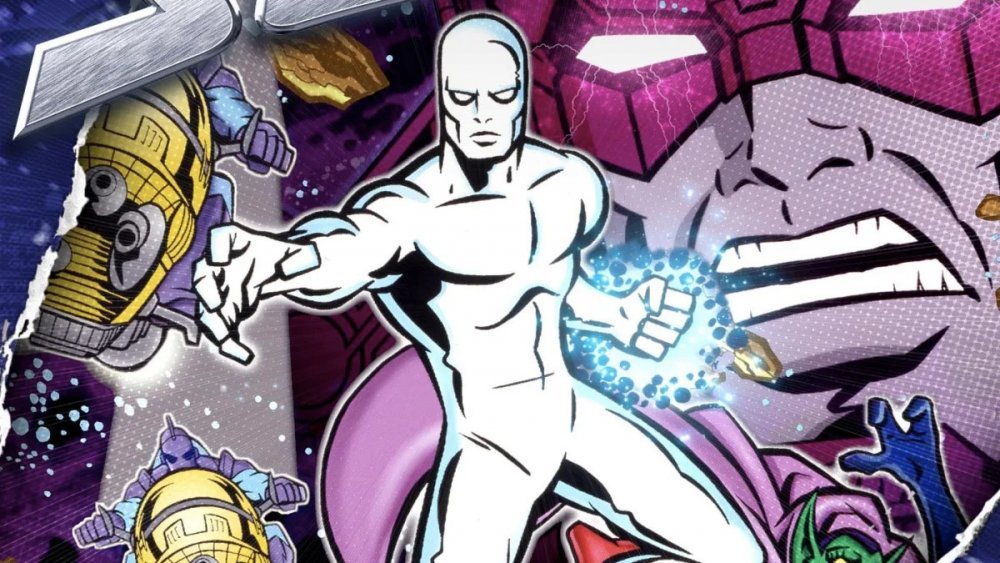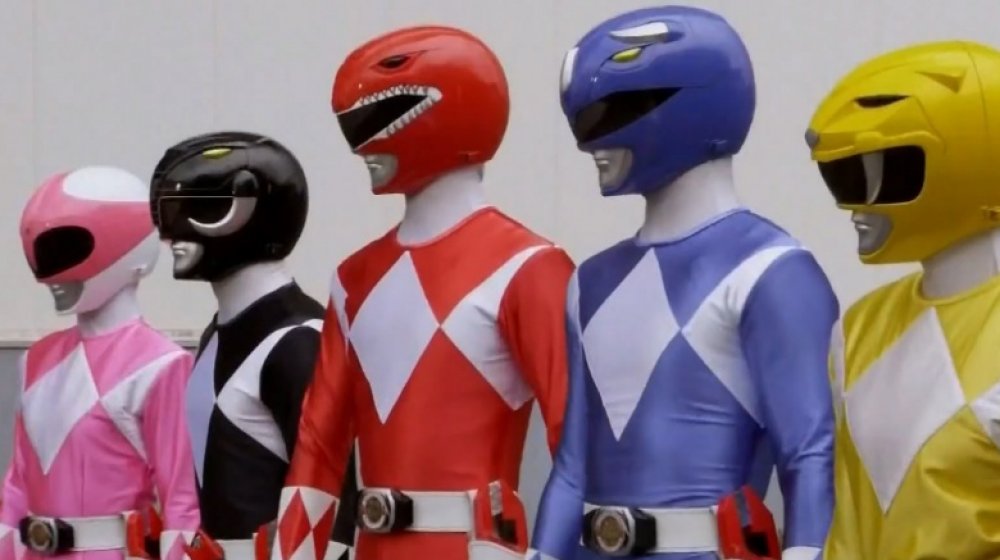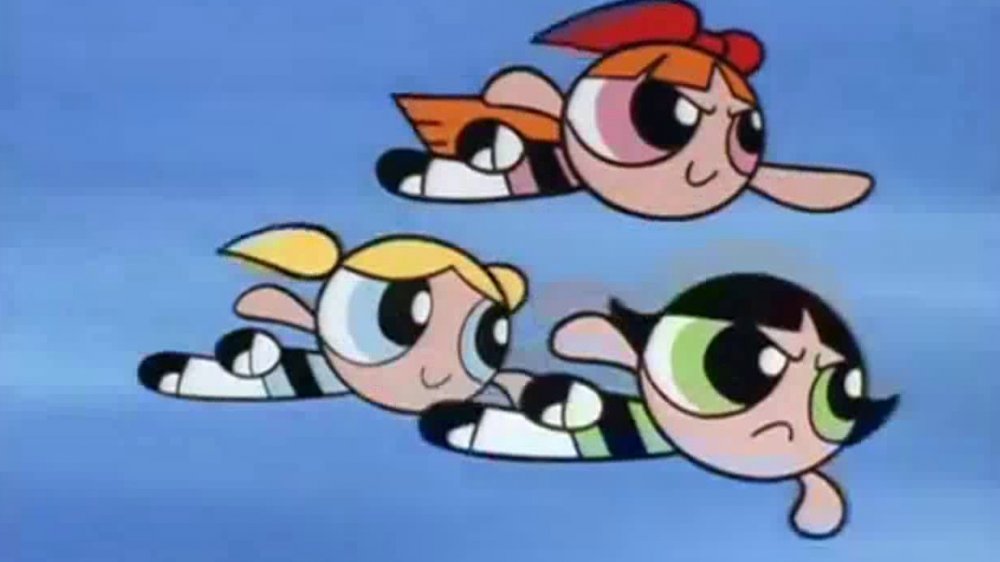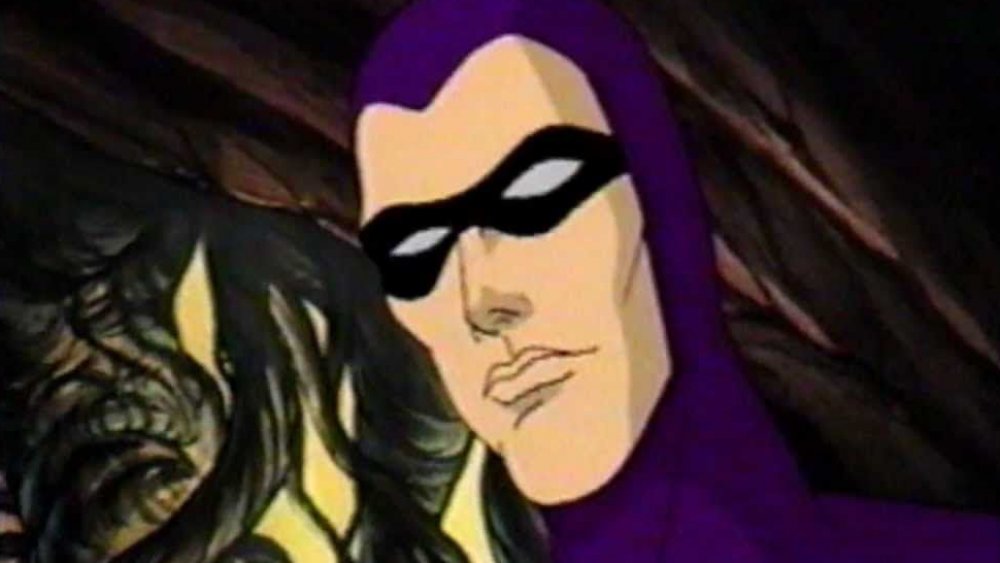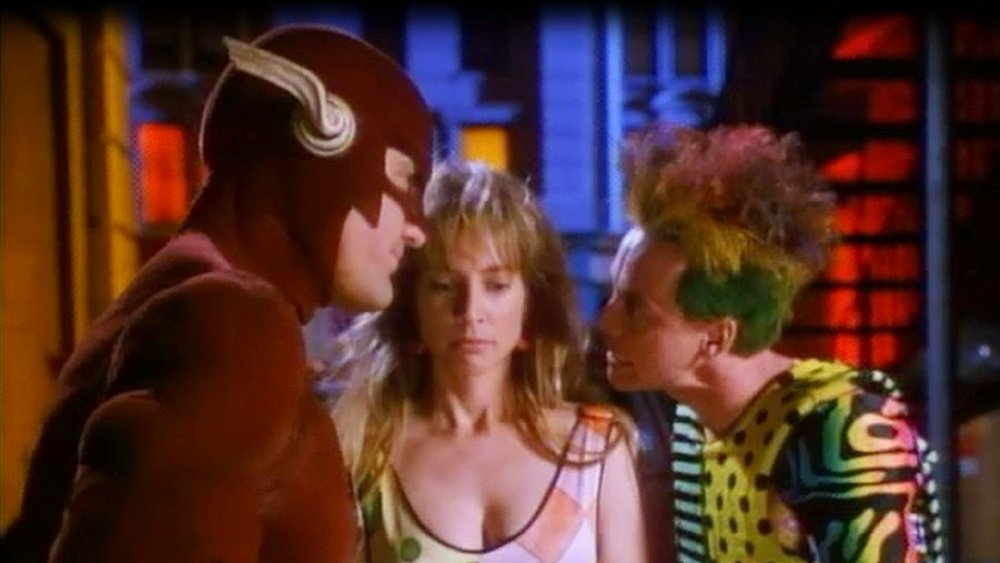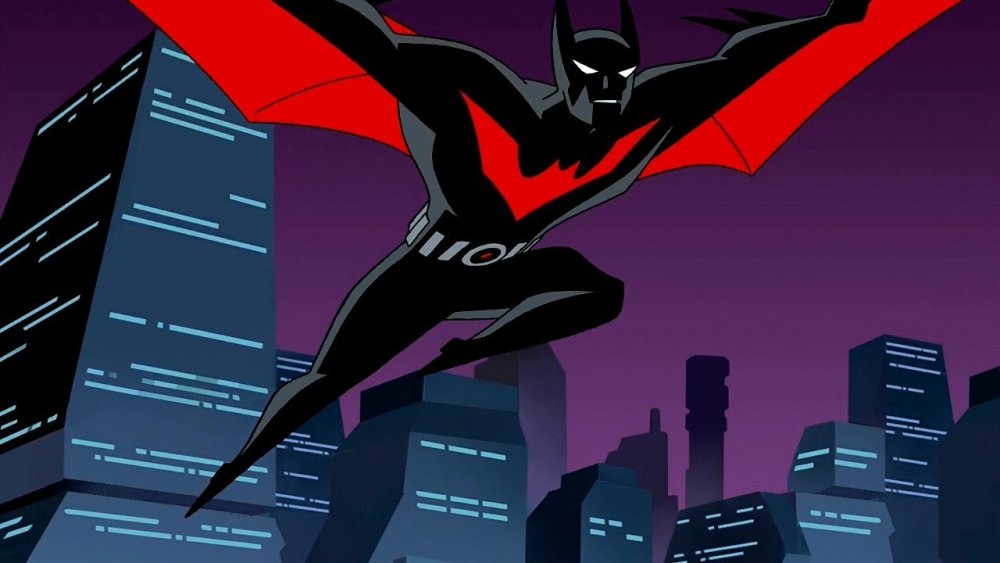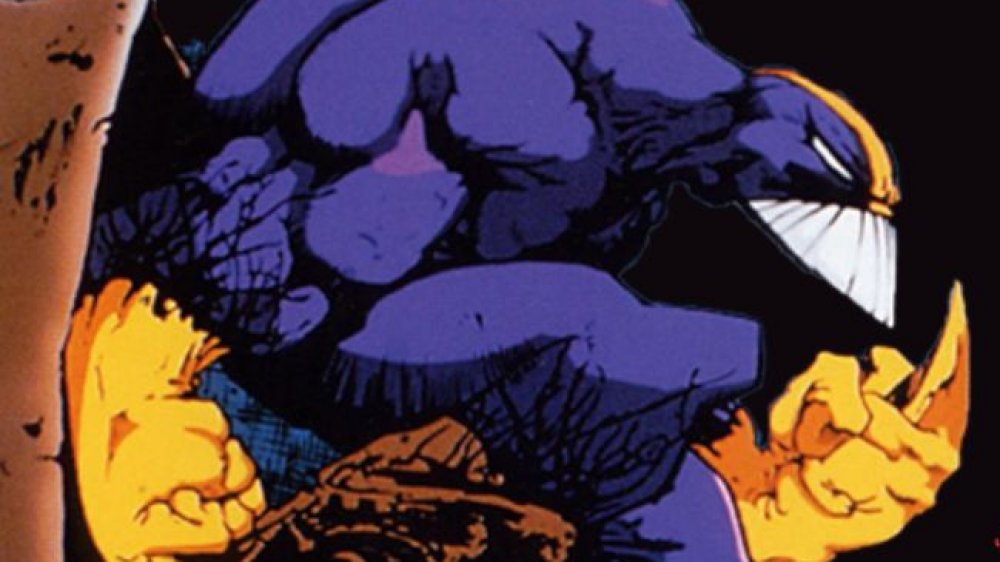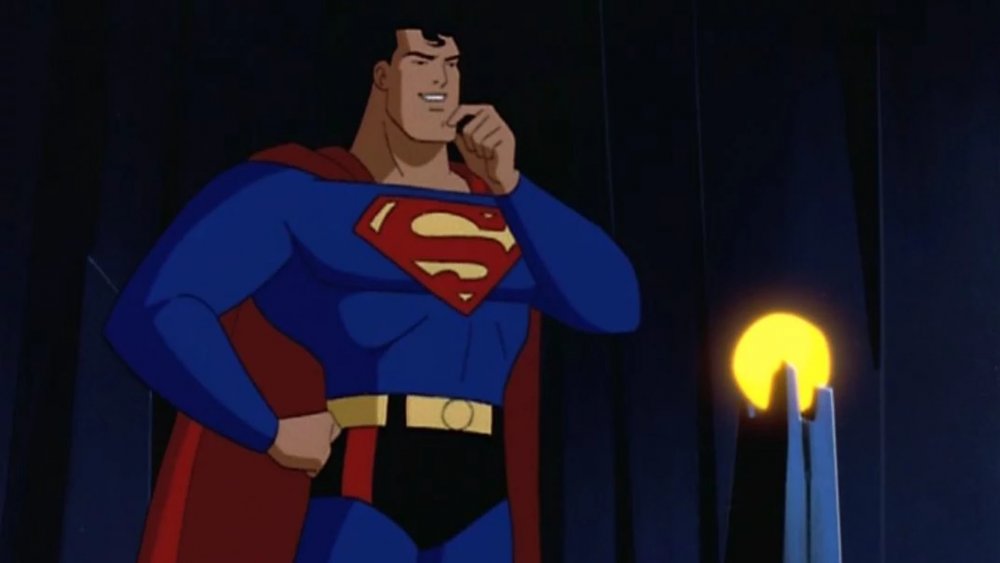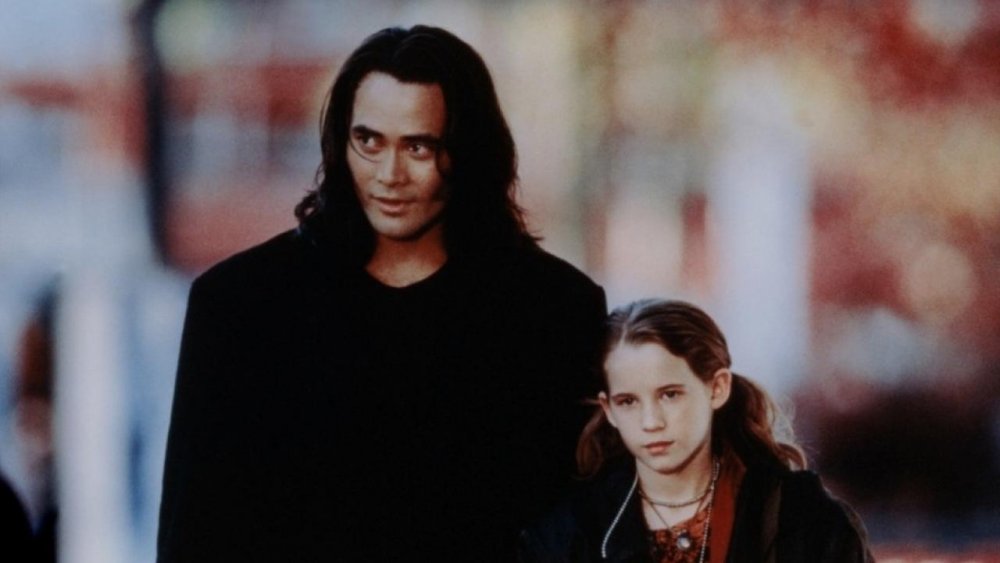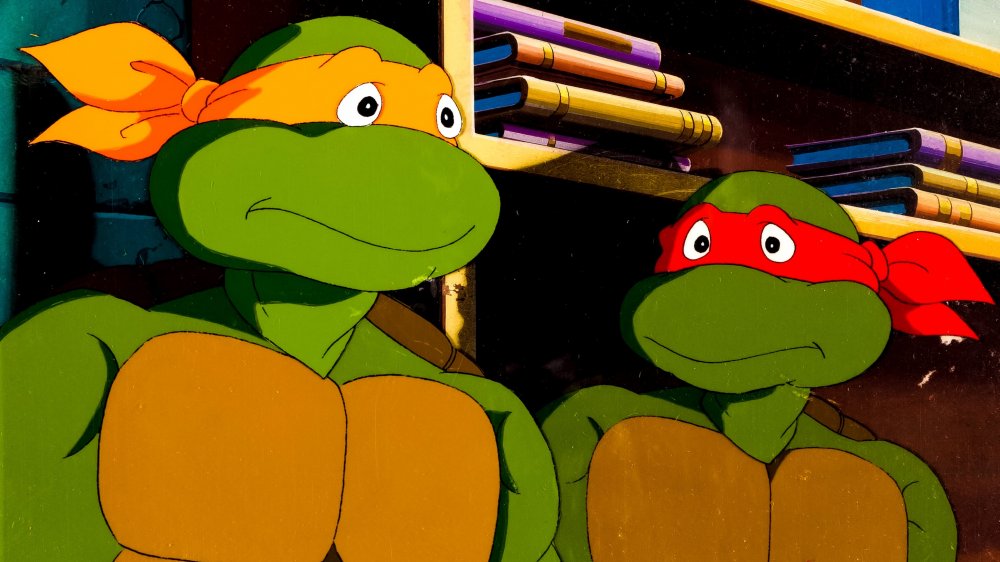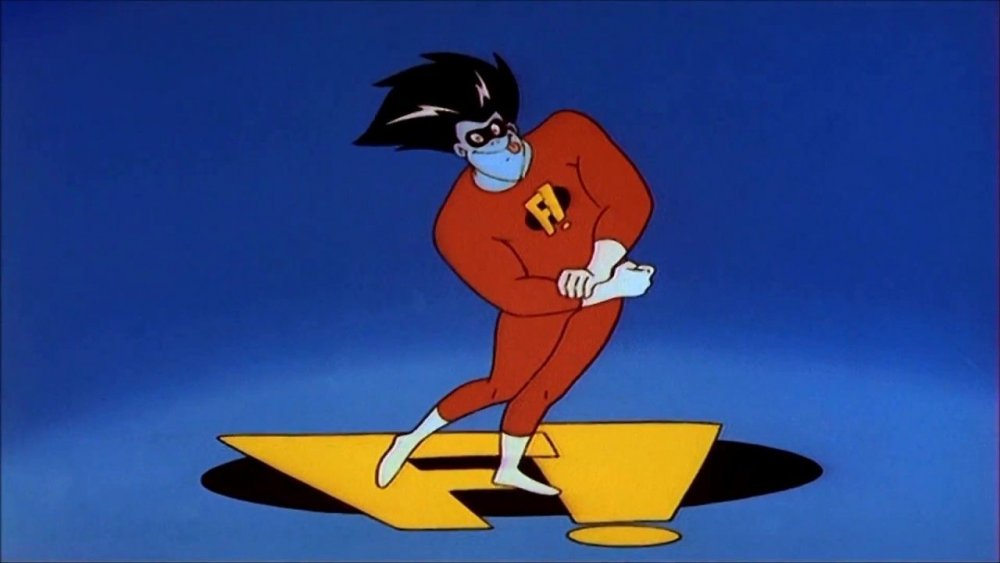The Best Superhero Shows Of The '90s
For a lot of people today, their fascination with superheroes didn't begin in the pages of a comic book. It began on their televisions, back in the '90s, when they had a big bowl of cereal in front of them. After all, superhero shows were huge in the '90s, and for many future fans, these TV characters would become the definitive versions of their favorite crime-fighters.
But hey, even though most of these series were geared towards children, plenty of them can be enjoyed by fans of all ages. And looking back today, it's easy to see why so many people remember these programs with such fondness. The best superhero shows of the '90s all have one thing in common. They'll make you feel nostalgic for the good old days when superhero stories were simpler, more straightforward, and way more fun. And today, we're shining on a light on the best of the best, from landmark series to some pretty obscure shows.
Batman: The Animated Series gave us some iconic characters
There's a significant number of people out there who when you ask them who their favorite Batman is, their answer isn't Christian Bale or Michael Keaton. It's Kevin Conroy. Batman: The Animated Series excelled at mastering the tone of what a superhero cartoon could be. It was appropriate for kids, but there was still a certain level of darkness that made the series mature enough for adults. The show also brought us definitive versions of many of Batman's best villains.
For example, "Heart of Ice" isn't just one of the best episodes of the series, it also completely reinvented the character of Mr. Freeze. For years, he had just been a gimmicky villain who had ice powers. This series introduced a layer of complexity to him that would influence every version of the character to come out since.
The show also introduced the world to Harley Quinn, who's now one of the most popular superhero characters ever. Batman: The Animated Series wasn't just a way to sell comic books to kids. It was a way to define these characters for a new generation and make them relevant once again.
Lois & Clark: The New Adventures of Superman reinvigorated interest in the character
Superman on the big screen fizzled out in the late '80s. While 1978's Superman is rightfully a classic that introduced the character to a new generation of moviegoers, 1987's Superman IV: The Quest for Peace was widely panned by critics. The character was in need of a reboot, and he found one on television in the form of Lois & Clark: The New Adventures of Superman.
The TV series was a hit thanks to its soap opera approach of focusing on the relationship between Clark Kent and Lois Lane. The show is also responsible for one of the biggest comic book stories of the '90s, "The Death of Superman." The comic book writers wanted to marry Clark and Lois, but they knew the TV series wanted to do the same. To promote corporate synergy, they had to find a way to delay that particular story arc, so they came up with the idea of killing Superman.
But apart from its influence on the world of comic books, Lois & Clark can stand on its own merits, especially if you're looking for a show that puts just as much emphasis on relationships as it does adventures. While it's pretty different from the Man of Steel we all know today, it's that soap opera element that really makes the series stand apart from its super peers.
Spider-Man brought joy to Saturday mornings
Spider-Man jumped off the pages and onto TV screen in 1967, but these days, that original cartoon is pretty much only remembered for the memes that came out of it. But for the next generation of kids, the definitive version of Spider-Man was the one who swung onto their TVs from 1994 to 1998. Spider-Man: The Animated Series chronicled the adventures of Peter Parker as he juggled the responsibilities of being a superhero with being a student at Empire State University.
The show was great for how it really dove into Spider-Man's rogue gallery. You had all of the fan favorites like Venom and Green Goblin, but lesser-known villains such as the Owl, Tombstone, and even Dormammu also showed up during the show's run. The series was also excellent at adapting comic book storylines. For example, Spider-Man eventually received the symbiote suit, and there was even an adaptation of the Clone Saga. For kids, it was like seeing a genuine comic book come to life on their TVs.
X-Men is a major source of '90s nostalgia
The theme song for X-Men: The Animated Series is just as beloved as the series itself. However, this wasn't the first time Marvel tried to get the X-Men on the small screen. A pilot called Pryde of the X-Men was made but ultimately passed over. Fortunately, the chance for another X-Men show came when Margaret Loesch was tapped to be head of the Fox Children's Network. The result was one of the most fun and colorful superhero adaptations of the decade.
The show may have had plenty of action, but it also dealt with a lot of issues you wouldn't normally expect out of a children's cartoon. The "Time Fugitives" arc in season two can be seen as an allegory to the AIDS epidemic, which was extremely timely in the early '90s. On top of all that, complex storylines and artwork that looked like it came from Jim Lee defined the series. The best part is you can take a trip down memory lane any time you want now that the series is available on Disney+.
Silver Surfer was a short-lived hit
A lot of Marvel shows debuted on Fox Kids in the '90s, and none were as dark as Silver Surfer. The show separated the character from the Fantastic Four and focused on the titular character betraying Galactus to try to save Earth. The Surfer then travels across the universe trying to find a new homeworld, and along the way, he runs into other comic book characters like Drax the Destroyer and Ego the Living Planet, both of whom would become more well-known with the release of the Guardians of the Galaxy franchise decades later.
The show was heavily influenced by the comic books, both in its art style and the stories it chose to tell. There were episodes dealing with a wide range of political issues, including environmental destruction and imperialism. But while the creators planned on doing a second season, the show was unfortunately canceled before anything could go into production. Still, if you want a different kind of animated superhero show, then Silver Surfer is the one to revisit.
Mighty Morphin Power Rangers is landmark superhero show of the '90s
Superheroes in the '90s didn't have to debut in the pages of a comic book. Mighty Morphin Power Rangers instead drew inspiration from Toei's Super Sentai franchise, using footage from that old Japanese program to deliver a new and unique show for kids in the United States. In the series, five teenagers with attitude are selected to defend the planet from Rita Repulsa and her army of monsters as they attack Angel Grove.
The original iteration of the characters lasted for three seasons, but you just can't kill a concept this good. Mighty Morphin Power Rangers was followed by Mighty Morphin Alien Rangers and then Power Rangers Zeo. Every fan has their own personal favorite version of the Power Rangers, and there are no wrong answers. Interest in the franchise is still high with a live-action movie having come out in 2017. As long as there are kids (and adults) who want to defend others from the forces of evil, there will always be a place for the Power Rangers in pop culture.
The Powerpuff Girls was awesome for kids and parents
In the late '90s, The Powerpuff Girls was an essential fixture on Cartoon Network's programming. The show followed the adventures of three little girls — Blossom, Bubbles, and Buttercup — who received extraordinary powers from Chemical X and now regularly save Townsville from evil. The show debuted in 1998, and the original version of these characters ended in 2005. But it's still a '90s show through and through, and that vibe extends to the reboot it received in 2016.
Kids loved the over-the-top action sequences and humor, and adults probably enjoyed some subtle innuendo only they could pick up. After all, it's not every day you see sexual references in a children's cartoon, and it's something you could only really get away with in the '90s. But it makes sense considering the show was originally supposed to be called "Whoopass Stew!". The show may have been toned down from its origins, but that only allowed an entirely new generation of viewers to appreciate the superhero action.
Phantom 2040 gave an old hero new life
The Phantom is one of the oldest superheroes, having made his debut in 1936 in a daily newspaper strip. He's a highly influential character, often being credited as the first superhero to wear a skintight costume, which would go on to become the standard for practically all superheroes in the decades since. He also popularized the idea of a mask with no pupils, which you've seen dozens of other heroes copy. However, unlike other superheroes, he doesn't have any special powers or abilities. He just uses his hyper intellect and strength to fight bad guys.
For 35 episodes between 1994 and 1996, he had his own series in the form of Phantom 2040. The series provided major updates for the character, taking place in the far-off future where the world has been ravaged by environmental degradation and only the wealthiest of the elite thrive. It's a timely show that's worth a rewatch if you can track it down. And while the series delivered some important themes, it never lost focus of its core, namely Kit Walker Jr. following in his ancestors' footsteps to become the 24th iteration of the Phantom. It's a wholly human show with an art style that rivals that of Batman: The Animated Series.
The Flash delivered campy, '90s goodness
John Wesley Shipp got his start on soap operas before he was offered the role of Barry Allen on The Flash. While the current version of the hero on The CW has been making waves for awhile, he owes a great deal of debt to the original 1990 version for paving the way for the speedster entering the zeitgeist. The original show borrows a great deal of its aesthetics from Tim Burton's Batman movies, and it all culminates in a superhero series that really carved its own path during the time period.
If you're a fan of The CW Flash, then you'll definitely want to check out this show at some point. After all, John Wesley Shipp plays Barry Allen's father on The CW version. And Mark Hamill, who showed up as the Trickster in The CW show, originated the part back in the '90s. But the series is enjoyable for more than just appreciating Easter eggs in the current version of the show. After all, the '90s Flash is a fun, colorful series that was tragically cut short. Unfortunately, the show's budget was out of control, and it was canceled after just two seasons.
Batman Beyond carried on the Dark Knight's legacy
Batman Beyond debuted in 1999, solidifying its status as a '90s classic that put a unique spin on the Caped Crusader. The show takes place in the year 2039, when an elderly Bruce Wayne mentors a new Batman, Terry McGinnis, to fight a new league of evil in Gotham. He takes up the mantle of Batman and fights crime in the night while juggling the responsibilities of high school.
The show truly excelled in making this Batman all his own. He's not fighting new versions of Batman's classic villains. Instead, the creators wisely decided to give him his own unique rogue gallery to fight. Inque and Blight, in particular, are standouts with superb character designs that really make them feel part of this futuristic world.
And when the show does bring in older villains, it does so in interesting ways. For example, we see an elderly Bane ravaged by the effects of Venom (the addictive compound that gave him his strength) after taking it for so many years. It's haunting to see a normally strong villain weakened to such a state, but Batman Beyond wasn't afraid to pull any punches.
The Maxx gave '90s adults a superhero cartoon
Not all superhero shows of the '90s were appropriate for kids. The Maxx, which ran for 13 episodes in 1995, came on late at night on MTV as part of the channel's "Oddities" line-up. The show never really had a chance to dive into the psychology of the character since each episode was only about 12 minutes long, but what it lacked in substance, it more than made up for in style. The show frequently changed its animation from one episode to the next. It would go from traditional animation to computer-generated, and sometimes, it even went into live-action.
For the most part, the series was pretty much a faithful adaptation of the comics from Image. Many times, there would be word-for-word recreations of panels you saw in the books. Plus, it was a surreal show that delved into some pretty heavy subjects. The animation still holds up to this day, but it's pretty edgy, so just make sure the kids are in the other room if you decide to watch it again.
Superman: The Animated Series was the best version of the Man of Steel
It seems like a common question surrounding Superman these days involves figuring out how to make him relatable to modern audiences. While this often includes bringing a darker take on the character, the animated series from the '90s proved you can have entertaining, enjoyable Superman stories without having to sacrifice what makes Superman, well, Superman.
Spanning three seasons, Superman: The Animated Series had complex storylines, faithful adaptations of comic book plots, and superb voice acting. The series eventually crossed over with Batman: The Animated Series and delivered World's Finest, which portrayed Superman and Batman meeting for the first time. They don't get along initially, as to be expected, but they eventually team up to take down Lex Luthor and Joker.
Both series would eventually be spun off into Justice League and Justice League Unlimited. Combined, the four series deliver some of the greatest superhero stories you'll ever see, regardless of the medium.
The Crow: Stairway to Heaven carried on Brandon Lee's legacy
Alex Proyas' 1994 film The Crow has gone on to become a cult classic, especially since it marks the final film appearance of Brandon Lee. While a proper sequel came out in 1996, the legacy of the character continued with a Canadian television series called The Crow: Stairway to Heaven. The series is a loose adaptation of the original film, which portrays rock musician Eric Draven getting brutally murdered and sent back to Earth in an attempt to right what was wrong. He's guided by the Spirit Crow, which instills in him new powers to help him gain a chance at redemption.
A curse has long been associated with the character of the Crow, and that curse seems to have extended into this television series. A special effects explosion went wrong during filming, and a stuntman, Marc Akerstream, lost his life. The show lasted for only one season before it was canceled. Still, if you're a fan of the original film or want a little bit of dark fantasy mixed in with your superhero action, then Stairway to Heaven might be the perfect, brooding show for you.
Teenage Mutant Ninja Turtles was fun in a half shell
It's hard to imagine any group of heroes having any greater success in the '90s than the Teenage Mutant Ninja Turtles. While the cartoon debuted in 1987, it lasted all the way to 1996. The show's popularity was further intensified thanks to the release of the 1990 film based on the titular heroes in a half shell.
There really was no escaping turtle mania in the '90s as you would find their faces on pretty much everything under the sun. They had plush toys, breakfast cereals, and even a rock show based on their escapades. They also had some of the best action figures you could buy at the time. The world was obsessed with these heroes.
There have been plenty of other shows centered around the Teenage Mutant Ninja Turtles over the years, but none have quite reached the heights as this one. With nearly 200 episodes, there are plenty of adventures for '90s kids to look back on.
Freakazoid showed off a superhero's funny side
Paul Dini and Bruce Timm were riding high off the success of Batman: The Animated Series in the early '90s. The duo proved they had enough gas left in the tank to produce another beloved superhero series, and Freakazoid! was born. The show follows Dexter Douglas, who has the ability to transform into the bizarre superhero named, you guessed it, Freakazoid.
Where Freakazoid! really differed from its contemporaries was its tone. Other superhero shows were light in nature, but Freakazoid! leaned heavily into slapstick humor and pop culture references. It made more sense running alongside Animaniacs than X-Men, and that was perfectly all right with a generation of superhero lovers.
In today's world, where superhero properties are as dark and grim as possible, a little levity would sure be appreciated. If there were ever a time to reboot such a popular character who would have a lot of success in the 21st century, now would be it.
